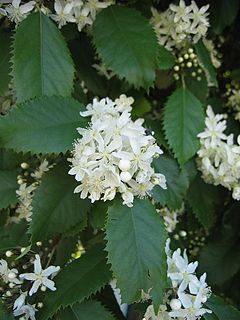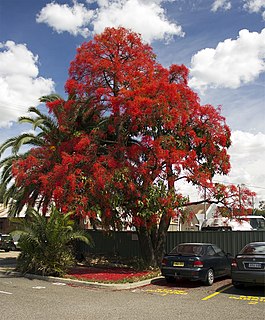This page is based on this
Wikipedia article Text is available under the
CC BY-SA 4.0 license; additional terms may apply.
Images, videos and audio are available under their respective licenses.
Binomial nomenclature, also called binominal nomenclature or binary nomenclature, is a formal system of naming species of living things by giving each a name composed of two parts, both of which use Latin grammatical forms, although they can be based on words from other languages. Such a name is called a binomial name, a binomen, binominal name or a scientific name; more informally it is also called a Latin name. The first part of the name – the generic name – identifies the genus to which the species belongs, while the second part – the specific name or specific epithet – identifies the species within the genus. For example, humans belong to the genus Homo and within this genus to the species Homo sapiens. Tyrannosaurus rex is probably the most widely known binomial. The formal introduction of this system of naming species is credited to Carl Linnaeus, effectively beginning with his work Species Plantarum in 1753. But Gaspard Bauhin, in as early as 1623, had introduced in his book Pinax theatri botanici many names of genera that were later adopted by Linnaeus.

Nightjars are medium-sized nocturnal or crepuscular birds in the subfamily Caprimulginae and in the family Caprimulgidae, characterised by long wings, short legs and very short bills. They are sometimes called goatsuckers, due to the ancient folk tale that they sucked the milk from goats, or bugeaters, due to their insectivore diet. Some New World species are called nighthawks. The English word 'nightjar' originally referred to the European nightjar.

The nutcrackers (Nucifraga) are a genus of three species of passerine bird, in the family Corvidae, related to the jays and crows.

A botanical name is a formal scientific name conforming to the International Code of Nomenclature for algae, fungi, and plants (ICN) and, if it concerns a plant cultigen, the additional cultivar or Group epithets must conform to the International Code of Nomenclature for Cultivated Plants (ICNCP). The code of nomenclature covers "all organisms traditionally treated as algae, fungi, or plants, whether fossil or non-fossil, including blue-green algae (Cyanobacteria), chytrids, oomycetes, slime moulds and photosynthetic protists with their taxonomically related non-photosynthetic groups ."
Ribbonwood is a common name for several plants, they are like the lacebarks, ribbonwood has an inner layer of bark made up many lace-like layers, which can be torn into ribbon-like strips, and may refer to:
In zoological nomenclature, the specific name is the second part within the scientific name of a species. The first part of the name of a species is the name of the genus or the generic name. The rules and regulations governing the giving of a new species name are explained in the article species description.
The Chinese Elm cultivar Ulmus parvifolia 'Zettler' is one of three recent American introductions selected for their cold hardiness.
The Chinese Elm cultivar Ulmus parvifolia 'Glory' is one of the early American selections, best known for its winter hardiness.
In scientific nomenclature, a synonym is a scientific name that applies to a taxon that (now) goes by a different scientific name, although the term is used somewhat differently in the zoological code of nomenclature. For example, Linnaeus was the first to give a scientific name to the Norway spruce, which he called Pinus abies. This name is no longer in use: it is now a synonym of the current scientific name, Picea abies.
The Chinese Elm cultivar Ulmus parvifolia 'Garden City Clone' was raised in Kansas. The champion tree was 18 m tall in 1993; however, the name 'Garden City Clone' is not officially recognized.

Brachychiton populneus, commonly known as the kurrajong, is a small to medium-sized tree found naturally in Australia in a diversity of habitats from wetter coastal districts to semi-arid interiors of Victoria, New South Wales and Queensland. The extended trunk is a water storage device for survival in a warm dry climate. The bell-shaped flowers are variable in colour while the leaves vary considerably in shape. The leaves are either simple and pointed, or may be 3–9 lobed. Saplings grow from a drought and fire resistant tap-rooted tuber.
Lacewood is a common name for the wood produced from a number of different trees, with mostly a striking appearance of their "lace-wood“, which gets its name from the lacelike pattern: These include:
The Chinese Elm cultivar Ulmus parvifolia 'Emerald Prairie' was raised by Kansas State University and released in 2004.
Houhere is the Māori language name for a genus of plants called Hoheria or lacebark, and may refer to the following plants from New Zealand:

Hoheria populnea, commonly known as New Zealand mallow, lacebark or houhere, is a species of flowering plant in the family Malvaceae, endemic to New Zealand.

Hoheria angustifolia, the narrow-leaved lacebark or narrow-leaved houhere, is a species of flowering plant in the family Malvaceae, endemic to New Zealand.







